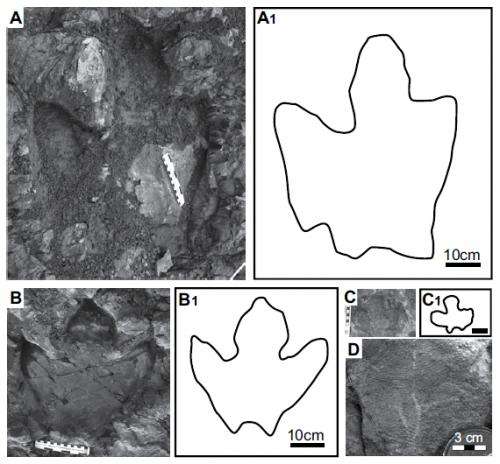July 10, 2014 report
Preserved tracks in Alaska park suggest duck-billed dinosaurs lived in Arctic year-round

(Phys.org) —A trio of researchers has published the results of a study of dinosaur tracks found in Alaska's Denali National Park in 2007. Anthony Fiorillo, Stephen Hasiotis and Yoshitsugu Kobayashi, of the Perot Museum, the University of Kansas and Hokkaido Museum respectively, report, in an article published in the journal Geology, on their analysis of 70 million year old hadrosaur footprints and what they revealed about the lifestyle of the dinosaurs.
Hadrosaurs, more commonly referred to as duck-billed dinosaurs (because of their unique crest) lived approximately 69 to 72 million years ago—there were several species living on several different continents. In this study of the preserved footprints found in Alaska, the researchers found evidence of both pack and family behavior.
The footprints were found on a piece of land not much bigger than a soccer field—scientists working there found thousands of preserved tracks from several types of animals and insects—all living during the during the Late Cretaceous. In this study, the emphasis was on the hadrosaurs.
The team found footprint size ranged from 8 to 64 centimeters, which they said could be attributed to dinosaurs of four different groups: adults, near-adults, juveniles, and the very young. The majority of the tracks were made by adults or those close to being full grown—84 percent. Very young members made up 13 percent of the tracks while juveniles made up just 3 percent of the total. Because the tracks appear to have been made near in time to one another, the researchers suggest they offer evidence that the dinosaurs lived as family units within a herd. The small number of juvenile tracks, they add, likely means that the dinosaurs had a very short juvenile period—they probably grew pretty fast because at that stage they would have been very vulnerable to predators. Also, it appears unlikely the small dinosaurs would have been able to migrate, thus the footprints offer evidence that the dinosaurs lived in the Arctic year-round.
Scientists believe that the area in which the dinosaur tracks were found was more mild millions of years ago, likely closer to what is now typical for the Pacific Northwest, making it a suitable place for a hadrosaur to raise a family. The researchers note also that some of the tracks were so clear, it was possible to make out skin impressions, which offered clues as to what the bottoms of the feet looked like.
More information: Herd structure in Late Cretaceous polar dinosaurs: A remarkable new dinosaur tracksite, Denali National Park, Alaska, USA, Anthony R. Fiorillo, Stephen T. Hasiotis and Yoshitsugu Kobayashi, Geology published online 30 June 2014; DOI: 10.1130/G35740.1 . geology.gsapubs.org/content/ea … 5740.1.full.pdf+html
Abstract
The discovery of a new tracksite of mostly hadrosaurid dinosaur footprints, made by a herd living in an ancient high-latitude continental ecosystem, provides insight into the herd structure and behavior of northern polar dinosaurs and perspective on populations of large-bodied herbivores in an Arctic greenhouse world. This tracksite occurs in the Upper Cretaceous Cantwell Formation in the Alaska Range (Denali National Park, Alaska, United States), and it is the largest tracksite known from this far north. Preservation of the tracksite is exceptional: most tracks, regardless of size, contain skin impressions and they co-occur with well-preserved plant fossils and invertebrate trace fossils of terrestrial and aquatic insects. Statistical analyses of the tracks show that individuals of four different age classes of hadrosaurids lived together in a large social group. Our research results independently corroborate the growth curve for hadrosaurids proposed by paleohistologists that suggests that these dinosaurs experienced a period of rapid growth early in their life history.
Journal information: Geology
© 2014 Phys.org




















